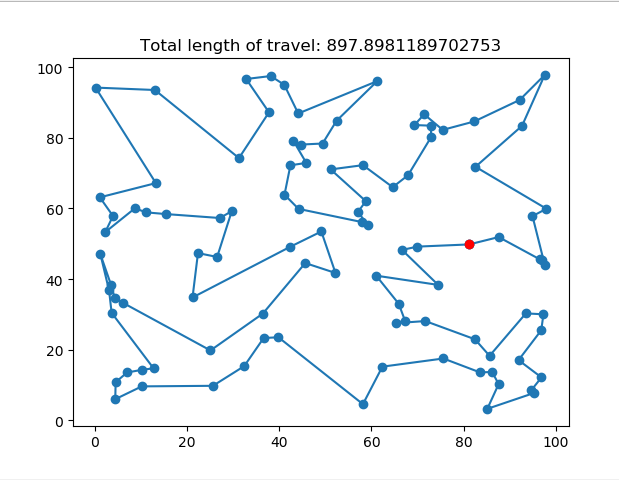玻尔兹曼分布
[P_T(X = i) = frac{e^{-frac{E(i)}{KT}}}{sum_{jin S}e^{-frac{E(j)}{KT}}}\
\E(i) 表示在i状态下的温度
\S表示所有的状态
\K表示玻尔兹曼常数
\T为材料当前的温度
]
思路介绍
如果从高温开始非常缓慢的降温,那么粒子可以在每个温度达到平衡
当系统完全冷却的时候,最终形成一个低能状态下的晶体
Metrppolis算法
- 当材料处于温度 T 时, 如果要进行状态 i->j的转换需要满足如下条件之一
- E(i)<E(j)
- 如果 E(j)>E(i) 那么状态转换接受的概率是 (e^{frac{e(i)-e(j)}{KT}})
作用:
求组合优化问题,最小值问题等
最终当T降到0时,Xi满足如下分布
[P_i^*=left{egin{aligned}
frac{1}{mid{S_{min}}mid},& &x_iquadinquad S_{min}\
0, & &其他
end{aligned}
ight.
]
并且可知:
[sum_{x_iin S_{min}}P_iquad=quad1
]
应用举例
解旅行商问题
-
目标函数:
总的距离
-
可行解:
所有坐标点的全排列
-
变换过程
将初始的排列的某一段反向
代码
import matplotlib.pyplot as plt
import numpy as np
import random
import math
a = np.random.rand();
point = np.random.rand(100,2)*100
# 计算每个点到每个点的距离
dist = np.zeros((100, 100), dtype=float)
for i in range(100):
for j in range(100):
dist[i][j] = math.sqrt((point[i][0]-point[j][0])**2 + (point[i][1]-point[j][1])**2)
# 多次随机试探求得一个相对较好的初始解
path = []
init = list(range(1,100))
length = float("inf")
for j in range(1000):
random.shuffle(init)
temp_len = 0
for i in range(1,99):
temp_len += dist[init[i-1]][init[i]]
temp_len += dist[0][init[0]]+dist[init[98]][0]
if temp_len<length:
path = init[:] # 深拷贝列表
length = temp_len
print("init path:{}".format(path))
print("init length:{}".format(length))
cur_path = [0]
cur_path.extend(path)
cur_path.append(0)
e = 0.1**30 # 提前跳出的条件
L = 20000 # 迭代的次数
at = 0.999 # 降温速度
T = 1 # 初始的温度,忽略了K,也就是取K等于1
for t in range(L):
# 生成一个新的路径
# 随机数取得中间的一段, 方法是把这一段路径反向, 这样计算距离更方便
c1, c2 = random.randint(1,99), random.randint(1,99)
if c1>c2:
c1, c2 = c2, c1
df = dist[cur_path[c1]][cur_path[c2+1]]+dist[cur_path[c1-1]][cur_path[c2]]-dist[cur_path[c1-1]][cur_path[c1]]-dist[cur_path[c2]][cur_path[c2+1]]
if df<0 or math.exp(-df/T)>random.random():
length += df
while c1<c2:
cur_path[c1], cur_path[c2] = cur_path[c2],cur_path[c1]
c1 += 1
c2 -= 1
T = T*at; # 每当有接受的, 就进行降温
if T<e:
break;
print(cur_path)
print(point[cur_path, 0])
print(point[cur_path, 1])
plt.plot(point[cur_path, 0], point[cur_path, 1], '-o')
plt.plot(point[0][0], point[0][1], 'ro')
plt.title("Total length of travel: {}".format(length))
plt.show()
print(length)
